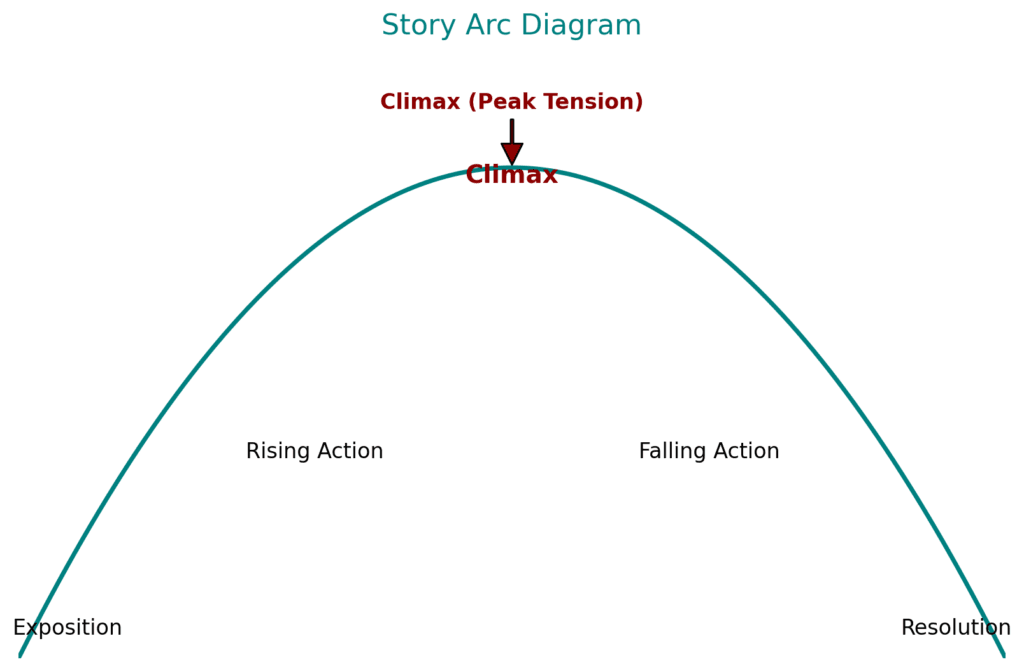The Power of the Climax
Readers expect stories to build toward a climatic moment, where tension peaks and conflicts reach resolution. When that climax is lacking, it often means your pacing is flat and this can leave readers feeling frustrated and unsatisfied. Below are a few examples of the different types of climax you can use in your story.
Confrontation
- Example: Harry Potter and the Deathly Hallows (Harry vs. Voldemort)
- Description: The protagonist directly faces the antagonist in a final showdown, often with everything at stake. Common in action, fantasy, and thrillers.
Revelation
- Example: Gone Girl by Gillian Flynn (Nick learns Amy’s plan)
- Description: A shocking truth or revelation changes the protagonist’s understanding, often forcing them to rethink everything. Great for mysteries and psychological thrillers.
Sacrifice
- Example: The Hunger Games by Suzanne Collins (Katniss and Peeta’s berry stunt)
- Description: The protagonist makes a self-sacrificial choice to protect others or defy the antagonist. Often used in dystopian and hero-driven stories.
Disillusionment
- Example: Divergent by Veronica Roth (Tris learns the truth about her society)
- Description: The protagonist realizes a harsh truth, often shattering their idealism or trust in others. Common in dystopian and coming-of-age stories.
Moral Choice
- Example: The Hate U Give by Angie Thomas (Starr decides to speak out)
- Description: The protagonist faces a tough choice that tests their values, often reshaping their identity. Great for socially driven or character-centered stories.
Redemption
- Example: A Man Called Ove by Fredrik Backman (Ove opens up to his community)
- Description: The character faces a personal reckoning and chooses integrity or love, often finding a path to redemption. Common in romance and drama.
Vindication
- Example: The Girl with the Dragon Tattoo by Stieg Larsson – Lisbeth and Blomkvist uncover the serial killer’s identity, and Blomkvist narrowly escapes.
- Description: The protagonist achieves justice or reveals their true strength, proving themselves against the odds. Common in mysteries and revenge narratives.
Fated Tragedy
- Example: Me Before You by Jojo Moyes (Louisa faces Will’s decision)
- Description: The protagonist encounters a tragic, inevitable outcome, often resulting from choices made earlier. Common in romance and drama.
Transformation
- Example: Eleanor Oliphant is Completely Fine by Gail Honeyman (Eleanor accepts her past)
- Description: A quiet but significant moment of personal change brings peace or self-acceptance. Often used in literary and character-driven fiction.
Heroic Sacrifice
- Example: Mockingjay by Suzanne Collins (Katniss’s final decision about Coin)
- Description: The protagonist sacrifices something important for the greater good, achieving victory by letting go. Common in hero and epic narratives.
How to Spot Where Your Climax Should Appear
The climax typically falls toward the end of the story, around the 75–90% mark. The earlier chapters establish the stakes, deepen character relationships, and introduce the main conflict, while the rising action intensifies the tension and obstacles.
The climax is the story’s peak, where key conflicts are confronted and either resolved or lost, leading into the falling action and resolution.

- Identify Key Conflicts: Locate your story’s central conflict. The climax should focus on this main issue.
- Build Tension Gradually:Make sure the events leading to the climax steadily increase tension and stakes, adding urgency to the story.
- Check Pacing: Examine your pacing to confirm that the climax arrives after a steady rise in action, maximizing its impact on the reader.
Reach Your Peak!
Still not sure where to place your climax? Don’t worry; I’m here to help, whether it’s by creating a beat sheet to track your key plot points, brainstorming ways to heighten the stakes, or refining the pacing to build up just the right amount of tension. Together, we’ll make sure we leave your readers feeling satisfied.


